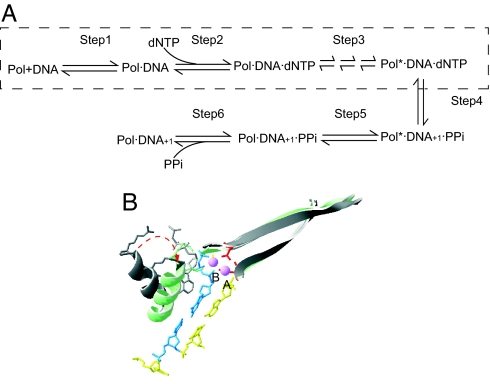Fig. 1.
Kinetic scheme and conformational change of DNA pols. (A) Minimum kinetic scheme shared by different DNA pols. To extend a primer, the following steps are required: Step 1, binding of DNA to form a binary complex; Step 2, binding of a dNTP substrate to form a ternary complex; Step 3, a series of conformational changes in the ternary complex that ensure proper alignment of the reactants; Step 4, phosphoryl transfer; Step 5, another conformational change that relaxes the complex; Step 6, pyrophosphate release and translocation of the DNA, bringing the P/T into a position poised for the next synthetic step. This scheme was adapted from ref. 7. The states accessible in our fluorescence assay are shown within the dashed rectangle. (B) Conformational change of T7 pol from the open form (gray; PDB entry 1SL0; ref. 7) to the closed form (in color; PDB entry 1T7P; ref. 7). Two structures are superimposed by aligning the polymerase palm domains. The conformational change occurs through coordination of Mg2+ (pink) by both the triphosphate moiety of the dNTP (blue) and two conserved residues with carboxylic side chains (red).

